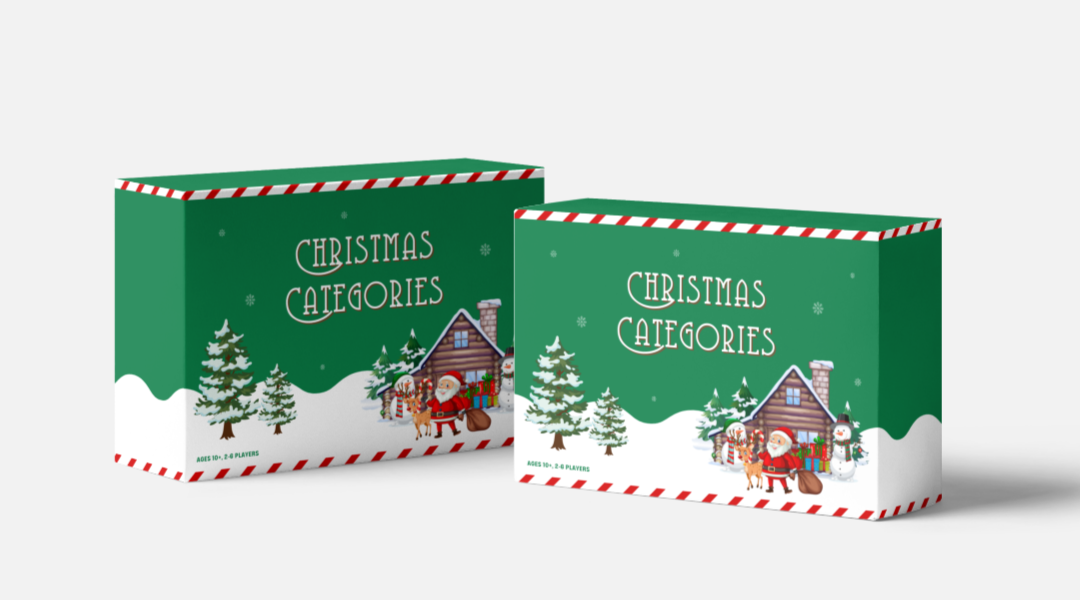Everyone has ideas on products they would like to create or see created. Brainstorming is easy, but going through the necessary steps to make those ideas exist in the real world can be a challenge. Say you want to develop a board game. Maybe you already have, bringing many fun times with friends and family, but now you want to market it to people all around the world. We did exactly that when we created Christmas Categories for our home brand Better Dweller. Here is a brief walkthrough on how our bestselling product came to fruition.
Step 1: Invent the Game
Categories is a classic parlor game played by coming up with various suitable words for certain prompts that all begin with the same letter. It was a favorite of President John F. Kennedy. Nearly two decades ago, my family came up with a version that was holiday-themed, as we spent hours coming up with relevant categories such as “Christmas movie title” and “Gift you might give your parents.” We played it every year as a special holiday addition to family game night.
Step 2: Solicit Suppliers
When we started sourcing products from China, we fostered relationships with various suppliers and their factories. This provided an opening for what once could only have been described as a pipe dream: Producing a commercial version of the game to share with families all around the world. Although sourcing is exponentially easier if you have relationships like we do (and speak Chinese), you can also look for suppliers on AliBaba. Make sure to get as many quotes as possible, and pay attention to the MOQ (Minimum Order Quantity).
In addition to competing on price, suppliers will also gladly provide samples of their wares so you can get a better understanding of the quality of their work. This step and the ones that follow take time, but it is important that you go to market with a high quality product. This is especially true since if your product is a success, the market will later be rife with shoddily made ripoffs from competitors. Be sure to also negotiate shipping prices. If your suppliers are not offering good rates, do your own research to see if it would be feasible to cheaply arrange the shipment from China yourself.
Step 3: Develop Prototype
Once you have found a supplier offering high quality and reasonable prices, it is time to make the prototype. In addition to the game mechanics, you need to find a designer for your box and any other artwork in the game. This could be you, an employee, or even a freelancer from a site like Upwork. Send the artwork, the text, and a precise description of exactly how you want the game to look to the supplier. Make sure to meet the formatting requirements given to you by the supplier. As they develop the prototype, they will send you proofs of everything to approve. Once everything looks good, they will produce the prototype. Congratulations! Your game exists. Under U.S. law, that means it officially receives U.S. copyright protection, though don’t be fooled into thinking this actually prevents any Chinese operation from making their own cheaper version for sale.
Producing the prototype takes about a month, and then it will take another few weeks for it to arrive in person at your doorstep. Take a look at it, play it with your friends and family, and decide if there are any last minute changes you want to make before entering mass production. If everything is up to your standards, you can give the go ahead to produce the first order. For our first run, the MOQ was 500 units. An order of this magnitude is relatively affordable and allows you to know if you have proof of concept for your idea.
Step 4: Sell & Market Your Game
Now it’s time to set up the point of sale for your product. You can do this on your own website via a service like Shopify or WooCommerce, but your best bet to start out is the tried-and-true method of Amazon. Take professional photos of your game, set up the listing with important keywords, run a PPC ad campaign (automated to start), and see what happens. It is also a good idea to identify influencers to create content around your product to share with their audiences.
That’s it! Your idea has now come to life and is available for purchase. Hopefully, people like it and it soon becomes time to place a new order. Try to place a larger order this time, since the higher your quantities the lower your per-unit cost. Also, pay attention to the customer reviews on your product. Treat them like mini focus groups. Identify any areas to change or approve for the next batch. These should ideally be minor and not add any time or costs to the next round of production. For Christmas Categories, we have had the luxury of increasing the quantity every year. In Year One, it was the MOQ of 500; Year Two was 5,000; Year Three was 10,000.
Christmas Categories has been a great success for Foxbat Media and the Better Dweller brand. With our expertise, we are happy to help make your dream a reality. Reach out to us if you have any questions about sourcing in China! The process can be daunting when you are just getting started, but it is all worth it when you see people enjoying the fruit of your labors.

